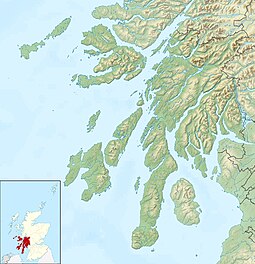Jura (Scotland)
| Gaelic name | |
|---|---|
| Norse name | Dýr-ey/Hjǫrt-ey |
| Meaning of name | Old Norse for 'deer island' |
| Location | |
|
Jura shown within Argyll and Bute
|
|
| OS grid reference | NR589803 |
| Coordinates | 56°00′N 5°54′W / 56°N 5.9°W |
| Physical geography | |
| Island group | Islay |
| Area | 366.92 km2 (142 sq mi) |
| Area rank | 8 |
| Highest elevation | Beinn an Òir 785 m (2,575 ft) |
| Administration | |
| Sovereign state | United Kingdom |
| Country | Scotland |
| Council area | Argyll and Bute |
| Demographics | |
| Population | 196 |
| Population rank | 31 |
| Population density | 0.5 people/km2 |
| Largest settlement | Craighouse |
| References | |
Jura (/ˈdʒʊərə/ JOOR-ə; Scottish Gaelic: Diùra [ˈtʲuːɾə]) is an island in the Inner Hebrides of Scotland, adjacent to and to the north-east of Islay. Compared with its fertile and more populous neighbour, Jura is mountainous, bare and infertile, covered largely by vast areas of blanket bog, hence its small population. In a list of the islands of Scotland ranked by size, Jura comes eighth, whereas ranked by population it comes thirty-first. It is in the council area of Argyll and Bute.
The modern name Jura dates from the Norse-Gael era. Two different Old Norse words have been suggested:
The latter possibility is generally ruled out, as the name of the island was recorded in 678 as Doraid Eilinn (essentially the gaelic for Dyrøy island, thus tautologously beast-island island).
With an area of 36,692 hectares, or 142 square miles (368 km2), and only 196 inhabitants recorded in the 2011 census, Jura is much more sparsely populated than neighbouring Islay, and is one of the least densely populated islands of Scotland. Census records show that Jura's population peaked at 1,312 in 1831, and that, in common with many areas of western Scotland, the island's population declined steadily over the ensuing decades. However, there has been a small increase since 2001. During the decade from 2001 to 2011 Scottish island populations as a whole grew by 4% to 103,702. Alongside the long-term decline in Jura's population has been a decline in the number of Gaelic speakers. The 1881 census reported that 86.6% (out of 946 inhabitants) spoke Gaelic. In 1961, for the first time less than half (46.9%) spoke the language and by 2001, this figure had dropped to 10.6%.
...
Wikipedia

